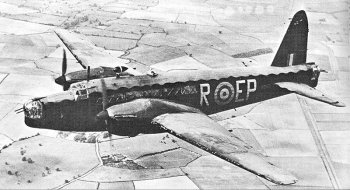![]() The Pacific War Online Encyclopedia
The Pacific War Online Encyclopedia
|
| Previous: Wellington | Table of Contents | Next: Wen Huai-kuang |

Vickers Wellington Mk.III
| Crew | 5 or 6 |
| Dimensions | 86'2" by 60'10"
by 17'5" 26.26m by 18.54m by 5.31m |
| Weight | 18,556-29,500 lbs 8417-13,400 kg |
| Maximum speed | 255 mph at 12,500
feet 410 km/h at 3800 meters |
| Climb rate | 16 feet per second 4.9 meters per second |
| Service ceiling | 19,000 feet 5800 meters |
| Power plant | 2 1500 hp (1118 kW) Bristol Hercules XI 14-cylinder radials driving three bladed propellers |
| Armament | 6 to 8 0.303
machine guns in nose and tail turrets and beam
positions |
| Bomb
load |
4500 lbs 2000 kg |
| Range | 2200 miles 3500 km |
| Production | 11,462 of all
models: |
| 1 prototype | |
| 3055 MkI | |
| 1519 Mk.III | |
| 220 Mk.IV | |
| 64 Mk.VI | |
| 397 GR.VIII | |
| 3803 Mk.X | |
| 180 GR.XI | |
| 58 GR.XII | |
| 844 GR.XIII | |
| 841 GR.XIV | |
| 80 T.XVIII | |
| Variants | The GR. versions were for maritime patrol while the T.XVIII was a trainer. Most of the maritime variants had ASV radar and Leigh lights. |
The Wellington "Wimpey" was the main
RAF bomber until the four-engine models came into production.
Introduced in 1938, the aircraft was a significant step forward
for the British in its day. Wellingtons
contributed to the first 1000-plane raid (on Cologne) and
saw
service in India. They proved
versatile, being adapted to a number of
roles, including magnetic minesweeping
using a 48' coil and antisubmarine
patrol using Leigh lights and
airborne radar.
The design used the geodetic construction of
Barnes Wallis and the prototype flew on 15 June 1936. Production
began
in December 1937.
References
The Pacific War Online Encyclopedia © 2007, 2010, 2016 by Kent G. Budge. Index